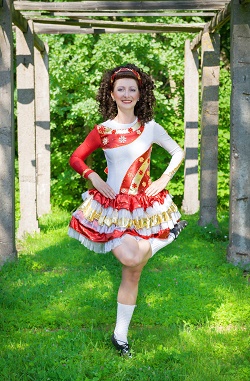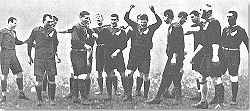
First a little background on the song itself. Harlech Castle was built in northern Wales by Edward I of England in the late 1200’s after he put down a Welsh rebellion against his rule. Harlech then became embroiled in the Wars of the Roses that raged between the houses of Lancaster and York in the 1400’s. From 1461 to 1468 the Lancastrians managed to hold onto the castle even as other strongholds fell to the Yorkists. Edward IV finally got fed up and ordered a huge army to besiege the castle, which surrendered after a month. This siege is often described as lasting for seven years, which is, we will charitably say, a slight exaggeration. The song originates from these events, but there are several versions and none of them was written before the 1800’s. It’s interesting to note that this stirring paean to freedom and bravery is actually about a civil war. One version includes the words “Now the Saxon flees before us . . . Britain wins the field!” So the Yorkists were seen as equivalent to the Saxon invaders of centuries before, but it’s fair to point out that the Lancastrians were being helped out by the French. Hmmm. Anyway, howe’er it was, the song itself is stirring and dramatic, and it’s very popular as a regimental march and is used in an adapted form by several Welsh football (er, rugby) teams.
Are the Welsh really allergic to vowels?
The second-longest known place name in the world refers to a location in Wales:
Llanfairpwllgwyngyllgogerychwyrndrobwllllantysilio-gogogoch
What does it mean? “Saint Mary’s Church in a hollow of white hazel near the swirling whirlpool of the church of Saint Tysilio with a red cave.” (Honesty forces me to admit that there are shorter forms of this name; the long version was invented in 1860 as a promotional tool.) How is it pronounced?
Why on earth is the Chorale singing the theme from the 1964 James Bond movie “Goldfinger”?

Well, I can’t say that I have any special insight into the sensibilities of the artistic committee; all I can do is repeat the words of our conductor: “Well, this is a Welsh concert, and Shirley Bassey is Welsh, so . . . “
I could go several directions in this post. One possibility is to give you the plot of the movie, but I’ve read a couple of versions and find them all pretty much incomprehensible. Another is to take you line by line through the lyrics of the song, but even my obsessive English-teacher tendencies don’t stretch that far. So we’re left with a third subject, actually the most intriguing: Shirley Bassey herself. Her life in and of itself could be made into a very interesting film.
Is Wales Known for its Ash Groves?
 When the choir to which I belong first started rehearsing “The Ash Grove” for a Celtic-themed concert in the spring of 2016, I thought, ‘Wait a minute–that tune is familiar. I’ve played it for church services.’ Turns out I was remembering “The Master Hath Come,” but two other hymns use the same tune, “Let All Things Now Living” and “Sent Forth by God’s Blessing.” Folk tunes are often used with varying lyrics; it’s a little ironic that this particular one made its way into the Christian hymnal, since the words most associated with it have pagan roots.
When the choir to which I belong first started rehearsing “The Ash Grove” for a Celtic-themed concert in the spring of 2016, I thought, ‘Wait a minute–that tune is familiar. I’ve played it for church services.’ Turns out I was remembering “The Master Hath Come,” but two other hymns use the same tune, “Let All Things Now Living” and “Sent Forth by God’s Blessing.” Folk tunes are often used with varying lyrics; it’s a little ironic that this particular one made its way into the Christian hymnal, since the words most associated with it have pagan roots.
The original lyrics have to do with what’s usually called “a sense of place.” As a certain site builds up associations because of events that have happened there, the place itself becomes suffused with meaning. So the speaker says that he sees “a host of kind faces” looking down on him whenever the wind rustles the branches. First are his childhood friends, but they are just a memory. He often roves pensively in the lonely ash grove, at twilight or in the moonlight. Then he meets “the joy of my life,” and builds his home there, while blackbirds and bluebells add to the happy scene.
How does this whole commissioning process work?
 Note to readers: This post was originally written in connection with a March 2016 concert by my own choir. I have left it as is, since it contains quite a bit of information about how commissions work and therefore should be of general interest.
Note to readers: This post was originally written in connection with a March 2016 concert by my own choir. I have left it as is, since it contains quite a bit of information about how commissions work and therefore should be of general interest.
So I started out by saying that we (that is, the Cherry Creek Chorale in the Denver area) had a number of commissioned pieces on our program for this concert, which raised the question above. So how does it all work?
Well, it depends. If I were to commission a wall hanging by a local artist to put in the stairwell of my home, that original physical item would belong to me. Beyond that ownership, though, there could be a number of permutations. I would have to spell out what other rights I wanted to purchase along with the item itself: Would I own the rights to the image or design? Could I make prints or copies of it and sell them? Would I have to give credit to the artist any time that a picture of my home was published that included the stairwell? Etc. It’s a very interesting and complicated issue.
Can the Lyrics in Our Set of “Birder” Pieces Be Explained?
 I will start out this post by quoting myself (how’s that for arrogance?) from what I wrote about the William Agee poem “This Shining Night” from a previous Christmas concert: “Poetry isn’t supposed to be an art form that can be reduced to simple explanations; otherwise, why write the poem at all? Just explain what you’re trying to say in a clear, concise paragraph and forget the versifying.” You can enjoy the imagery and wit in these four short lyrics without having any explanation or context. But if you’re like me, you’ll appreciate the words much more if you have some sort of context for them. I was very fortunate to find an article from The Guardian newspaper in its “poem of the week” column that makes various meanings clear without trying to take out all the mystery. I’d highly recommend reading it. (You can also read the poems in their entirety there. They are of course copyrighted, so I am including only short extracts below with the kind permission of the author, Gwyneth Lewis, and her publisher, Bloodaxe Books. Wouldn’t you just love to know how they came up with the name of that publisher? I don’t see any explanation on their website.)
I will start out this post by quoting myself (how’s that for arrogance?) from what I wrote about the William Agee poem “This Shining Night” from a previous Christmas concert: “Poetry isn’t supposed to be an art form that can be reduced to simple explanations; otherwise, why write the poem at all? Just explain what you’re trying to say in a clear, concise paragraph and forget the versifying.” You can enjoy the imagery and wit in these four short lyrics without having any explanation or context. But if you’re like me, you’ll appreciate the words much more if you have some sort of context for them. I was very fortunate to find an article from The Guardian newspaper in its “poem of the week” column that makes various meanings clear without trying to take out all the mystery. I’d highly recommend reading it. (You can also read the poems in their entirety there. They are of course copyrighted, so I am including only short extracts below with the kind permission of the author, Gwyneth Lewis, and her publisher, Bloodaxe Books. Wouldn’t you just love to know how they came up with the name of that publisher? I don’t see any explanation on their website.)
Why Is Mary Treated So Badly in “Téir Abhaile Riú”? Or . . . Is She?
 The translation of the title means “Go away home” or “home you’ll go.” A girl named Mary is told in no uncertain terms that she’d better “go away home and stay there because your (marriage) contract Is made.” It doesn’t matter whether or not she’s the one who made the contract; it’s done, and that’s it. Or, as the notes on one version of the sheet music say, “The girl, Mary, having been forced into an arranged marriage with a piper, is advised to go home and accept it.” Seems a little harsh, doesn’t it? And not the mood that would fit the rousing music. That meaning would mesh better with some kind of melancholy ballad, with perhaps the unhappy girl drowning herself at the end.
The translation of the title means “Go away home” or “home you’ll go.” A girl named Mary is told in no uncertain terms that she’d better “go away home and stay there because your (marriage) contract Is made.” It doesn’t matter whether or not she’s the one who made the contract; it’s done, and that’s it. Or, as the notes on one version of the sheet music say, “The girl, Mary, having been forced into an arranged marriage with a piper, is advised to go home and accept it.” Seems a little harsh, doesn’t it? And not the mood that would fit the rousing music. That meaning would mesh better with some kind of melancholy ballad, with perhaps the unhappy girl drowning herself at the end.
But I think this interpretation is mistaken. The website SongsInIrish.com says, “This traditional song teases the girl ‘Máire’ about her possible relationship with the piper at the dance. The singer and Máire argue back and forth about whether her ‘match is made.’”
What Do Tattoos and Tongue-Wagging Have to Do . . .
 . . . with the adoption of the Welsh national anthem?
. . . with the adoption of the Welsh national anthem?Several of Your Most Pressing Questions Answered about Rudolph the Red-Nosed Reindeer
 First of all, the burning question:
First of all, the burning question:
Did the original Rudolph live at the North Pole?
I always thought that, didn’t you? Rudolph was hanging around Santa’s workshop, bullied and left out, until the night when he was in the right place at the right time. Those other reindeer who wouldn’t play with him were the well-known Germanic-sounding troupe including Donder and Blitzen. Weren’t they? Well, no. Not in the story as initially written. For that, we have to go back to 1939, as the Great Depression waned, and visit the Chicago branch of Montgomery Ward, a member of that great department store chain whose catalogs provided so much reading material to lonely housewives out on the lone prair-ee. (The chain, often fondly called “Monkey Ward,” is alas no more, but I will proudly point out that my little portable sewing machine was bought at the Denver store more years ago than I care to think about. It’s still going strong, I’m happy to say.)
Why is the joyful “Carol of the Bells,” written in a minor key? Aren’t minor keys supposed to sound sad?

Now bear with me here. I’m not a music theorist, so you musicians reading this may wince a little in places. This post will be very much of a layperson’s view of the whole major/minor issue and its relationship to the mood of a piece. I’m probably spelling out more than I need to in places; no intention is meant to insult anyone’s musical intelligence!
